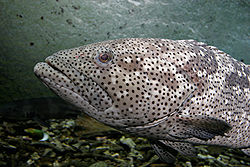This is an old revision of this page, as edited by Pinkfloyd5040 (talk | contribs) at 15:30, 28 September 2006. The present address (URL) is a permanent link to this revision, which may differ significantly from the current revision.
Revision as of 15:30, 28 September 2006 by Pinkfloyd5040 (talk | contribs)(diff) ← Previous revision | Latest revision (diff) | Newer revision → (diff)
| Groupers | |
|---|---|

| |
| Humpback grouper, Cromileptes altivelis | |
| Scientific classification | |
| Kingdom: | Animalia |
| Phylum: | Chordata |
| Class: | Actinopterygii |
| Order: | Perciformes |
| Family: | Serranidae |
| Subfamily: | Epinephelinae |
| Genera | |
|
Acanthistius | |
- For the computer program, see Grouper (Windows application).
Groupers are fish of any of a number of genera in the subfamily Epinephelinae of the family Serranidae, in the order Perciformes.
Not all serranids are called groupers; the family also includes the sea basses. The common name grouper is usually given to fish in one of two large genera: Epinephelus and Mycteroperca. In addition, the species classifed in the small genera Anyperidon, Cromileptes, Dermatolepis, Gracila, Saloptia and Triso are also called groupers. Fish classified in the genus Plectropomus are referred to as coral groupers. These genera are all classified in the subfamily Epiphelinae. However, some of the hamlets (genus Alphestes), the hinds (genus Cephalopholis), the lyretails (genus Variola) and some other small genera (Gonioplectrus, Niphon, Paranthias) are also in this subfamily, and occasional species in other serranid genera have common names involving the word "grouper". Nonetheless, the word "groupers" on its own is usually taken as meaning the subfamily Epinephelinae.
The word "grouper" comes from Portuguese "garoupa", and not from the English word group.
Interestingly, in New Zealand and Australia, the name for several species of Grouper is referred to as Groper, as in the Epinephelus lanceolatus Queensland Groper. In the Middle East, the fish is known as Hammour, and is widely eaten, especially in the Gulf Region.
Groupers are teleosts, typically having a stout body and a large mouth. They are not built for long-distance fast swimming. They can be quite large, and lengths over a meter and weights up to 100 kg are not uncommon, though obviously in such a large group species vary considerably. They swallow prey rather than biting pieces off it. They do not have much tooth on the edges of their jaws, but they have heavy crushing tooth plates inside the pharynx. They habitually eat fish, octopus, crab and lobster. They lie in wait, rather than chasing in open water. According to the film-maker Graham Ferreira, there is at least one record, from Mozambique, of a human being killed by one of these fish.
Their mouth and gills form a powerful sucking system that sucks their prey in from a distance. They also use their mouth to dig into sand in order to form their shelters under big rocks, jetting it out through their gills. Their gill muscles are so poweful, that it is impossible to pull them out of their cave if they feel attacked and extend them in order to lock themselves in.
Most fish spawn between May and August. They are protogynous hermaphrodite, i.e. the young are predominantly female but transform into males as they grow larger. They grow about a kilo per year. Generally they are adolescent until they reach three kilos, when they become female. At about 10 to 12 kilos they turn to male. Usually, males have a harem of three to fifteen females in the broader region. In the rare case that no male exists closeby, the largest female turns faster. Most males look much wilder and bigger than females, even if they happen to be smaller (compare bull to cow, or rooster to chicken, or lion to lioness).
Many groupers are important food fish, and some of them are now farmed. Unlike most other fish species which are chilled or frozen, groupers are generally sold alive in markets. Any species are popular fish for sea-angling. Some species are small enough to be kept in aquaria, though even the small species are inclined to grow rapidly. Pacific Rim blue-gill grouper have been known to swallow sharks whole; sharks almost the size of Volkswagens.
 |
 |
The species Epinephelus lanceolatus can grow very large: there have been reports of them growing big enough to swallow a human bather or even a scuba diver: for example, Arthur C. Clarke wrote that while scuba diving in an inlet on the coast of Sri Lanka he saw a grouper about 20 feet long, and 4 feet thick side to side, living in a sunken floating dock. Swallowing an ordinary open-circuit scuba diver would need a throat that can expand to about 2 feet square. It could be that Epinephelus lanceolatus does not grow that big more often because it needs a big enough shelter to hide from attack by sharks or seals, and that the situation may change if the current worldwide decimation of sharks for the shark fin trade continues. (There has been a report that the killing of sharks is leading to an increase in the number of groupers and thus a decline in the numbers of parrot fish and thus more algae overgrowing the coral reefs.)
Species of grouper include:
- Black grouper Mycteroperca bonaci
- Nassau grouper Epinephelus striatus